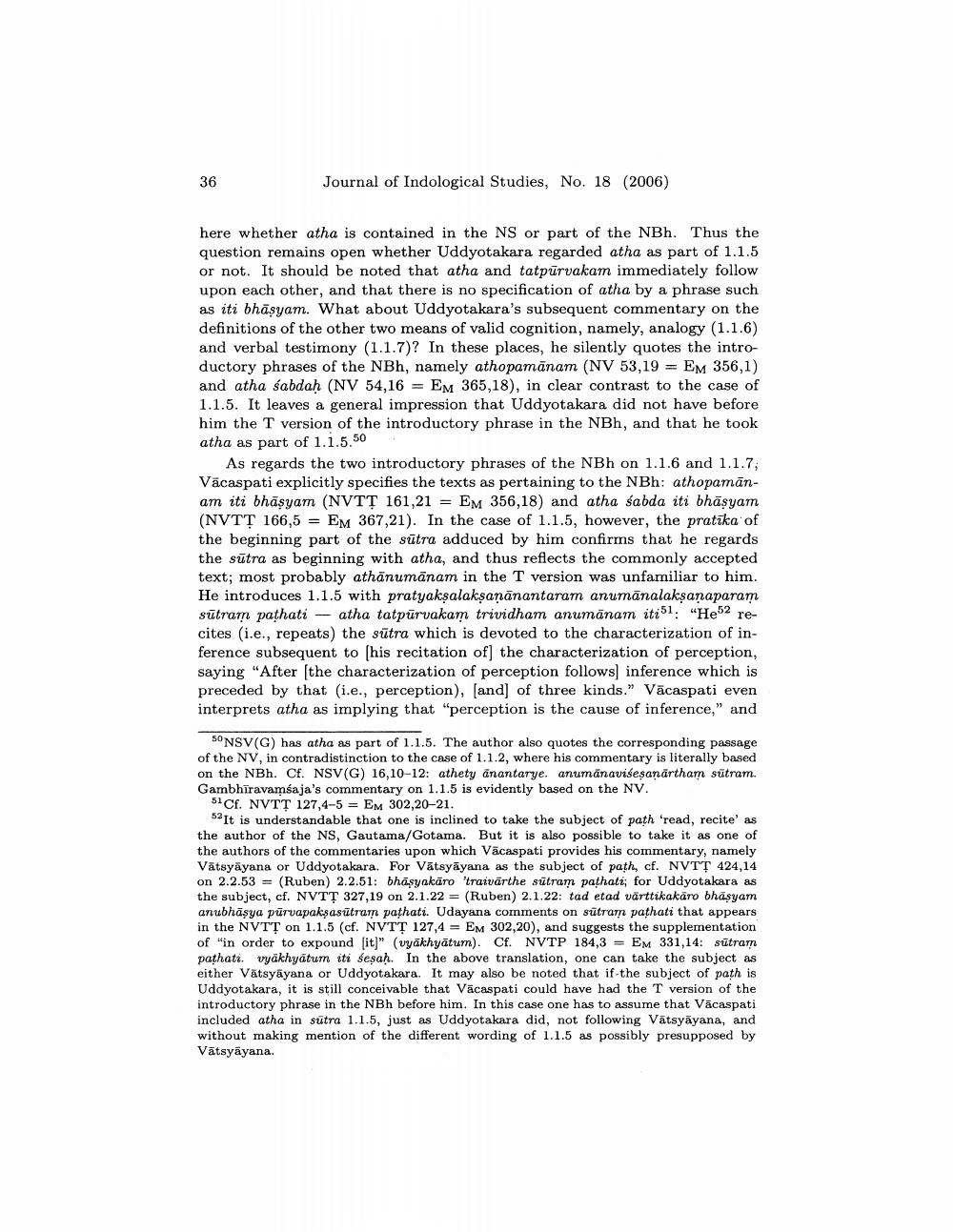________________
36
Journal of Indological Studies, No. 18 (2006)
here whether atha is contained in the NS or part of the NBh. Thus the question remains open whether Uddyotakara regarded atha as part of 1.1.5 or not. It should be noted that atha and tatpūrvakam immediately follow upon each other, and that there is no specification of atha by a phrase such as iti bhāsyam. What about Uddyotakara's subsequent commentary on the definitions of the other two means of valid cognition, namely, analogy (1.1.6) and verbal testimony (1.1.7)? In these places, he silently quotes the introductory phrases of the NBh, namely athopamānam (NV 53,19 = EM 356,1) and atha sabdah (NV 54,16 = EM 365,18), in clear contrast to the case of 1.1.5. It leaves a general impression that Uddyotakara did not have before him the T version of the introductory phrase in the NBh, and that he took atha as part of 1.1.5.50
As regards the two introductory phrases of the NBh on 1.1.6 and 1.1.7; Vācaspati explicitly specifies the texts as pertaining to the NBh: athopamānam iti bhāsyam (NVTȚ 161,21 = EM 356,18) and atha sabda iti bhāsyam (NVTT 166,5 = EM 367,21). In the case of 1.1.5, however, the pratika' of the beginning part of the sūtra adduced by him confirms that he regards the sūtra as beginning with atha, and thus reflects the commonly accepted text; most probably athanumānam in the T version was unfamiliar to him. He introduces 1.1.5 with pratyakşalaksaņānantaram anumānalaksanaparam sutram pathati - atha tatpūrvakam trividham anumānam iti51: "He52 recites (i.e., repeats) the sutra which is devoted to the characterization of inference subsequent to his recitation of] the characterization of perception, saying "After the characterization of perception follows) inference which is preceded by that i.e., perception), and of three kinds." Vācaspati even interprets atha as implying that "perception is the cause of inference," and
ONSV(G) has atha as part of 1.1.5. The author also quotes the corresponding passage of the NV. in contradistinction to the case of 1.1.2, where his commentary is literally based on the NBh. Cf. NSV(G) 16,10-12: athety anantarye. anumanavisesanārtham sūtram. Gambhiravamśaja's commentary on 1.1.5 is evidently based on the NV.
S1Cf. NVTT 127,4-5 = EM 302,20-21.
52 It is understandable that one is inclined to take the subject of path 'read, recite' as the author of the NS, Gautama/Gotama. But it is also possible to take it as one of the authors of the commentaries upon which Vācaspati provides his commentary, namely Vātsyayana or Uddyotakara. For Vātsyāyana as the subject of path, cf. NVTT 424,14 on 2.2.53 = (Ruben) 2.2.51: bhāsyakāro 'traivārthe sutram pathati; for Uddyotakara as the subject, cf. NVTȚ 327,19 on 2.1.22 = (Ruben) 2.1.22: tad etad värttikakāro bhāsyam anubhāsya pūrvapaksasutram pathati. Udayana comments on sūtram pathati that appears in the NVTT on 1.1.5 (cf. NVTȚ 127,4 = EM 302,20), and suggests the supplementation of "in order to expound (it)" (vyākhyātum). Cf. NVTP 184,3 = EM 331,14: sutram pathati. vyakhyātum iti sesah. In the above translation, one can take the subject as either Vätsyāyana or Uddyotakara. It may also be noted that if the subject of path is Uddyotakara, it is still conceivable that Vācaspati could have had the T version of the introductory phrase in the NBh before him. In this case one has to assume that Vācaspati included atha in sutra 1.1.5, just as Uddyotakara did, not following Vätsyāyana, and without making mention of the different wording of 1.1.5 as possibly presupposed by Vātsyāyana.




